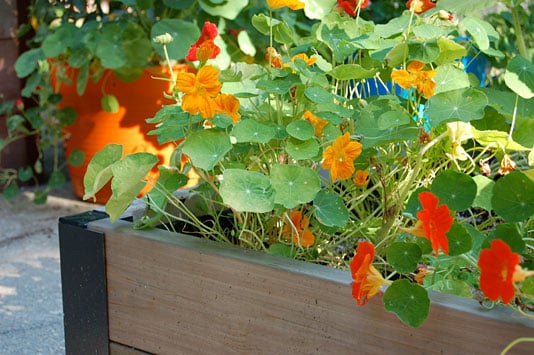How to Grow Nasturtiums from Seed
 Not only are nasturtiums beautiful, they are edible.
Not only are nasturtiums beautiful, they are edible.What are some easy annuals to start from seed?"
When I get that question, I always include nasturtiums on my list of suggestions.
With their large, water lily-like leaves, and their cheery blooms ranging from creamy yellow to bold orange to deep burgundy, nasturtium are extremely popular additions to the garden. Nasturtiums have edible flowers that taste peppery, like watercress. All colors and varieties are tasty in salads or as garnishes. Leaves can be eaten, too. Their large, easy-to-handle seeds are excellent for children — combined with their bright, edible blooms, nasturtium are excellent additions to school gardens and sensory gardens.
Types of Nasturtium
Mounding Types: Also called "bush types", these remain relatively compact. Place in planters or tuck between cucumber and squash rows in your raised bed.
Trailing or Climbing Types: Grow in a window box hanging basket, where they can drape over the side and provide cascading greenery and color. Alternatively, provide a small trellis or obelisk — while not quite as agressive as morning glories or clematis, nasturtium will climb a support.
How To Plant Nasturtium Seeds
Starting Nasturtium Indoors
If you want to start with larger plants — and get earlier blooms — start the seeds indoors.
- Nasturtium seeds are large, so start with a relative large, 2-3/4" or 3" seed starting pot. To prevent transplant shock, try using a biodegradable container.
- Put two seeds (1" deep) in each pot and grow them under lights or in a bright location, such as a south-facing window. It takes about 10 to 12 days for nasturtiums to germinate.
- When the seedlings have a few sets of leaves, pinch out the weaker seedling, leaving one per pot. Why plant two seedlings when you're going to pluck out the weaker one? It's mostly for insurance, in case one of the seeds fails to germinate. If you're feeling confident about your seed source — or thrifty — go with smaller pots and plant one seed in each.
When the weather moderates and nighttime temperatures are in the 50s, I harden off the seedlings. This involves moving them outdoors during the day and bringing them in at night. After a couple days, I plant them in the garden.
Direct Sowing Nasturtium Outdoors
Also known as "direct sowing," this technique is sometimes used instead of planting indoors. It's a good choice for seeds that don't require a lot of coddling, or seedlings that suffer from transplant shock.
- In the case of nasturtiums, wait till the danger of frost has passed — nasturtium are not frost-hardy. Not sure when the risk of frost has passed? Use this Garden Planting Calendar.
- Plant nasturtium seeds 1/2-1 inch deep and about 10 inches apart. Nasturtium have no specific soil requirements; just be sure it is a well-drained area that receives plenty of sun.
Direct sowing is sometimes risky because you might pull up the seedlings when you're weeding the bed. To prevent accidental weeding, mark the planting site with a label. Because of the distinctive foliage, nasturtium seedlings are easy to spot.
How To Care For Nasturtium Plants
Nasturtiums are fairly carefree and don't need much coddling or pruning:
- Plant in full sun. They will grow in part shade, but not flower as heavily.
- Plant in well-drained soil and be sure to water regularly.
- No fertilizer is necessary, however amending your soil with a healthy dose of compost will benefit your naturtium plants.
Related Articles
Print this Article:
Get the Dirt
Stay up to date on new articles and advice. Please fill out the information below.


